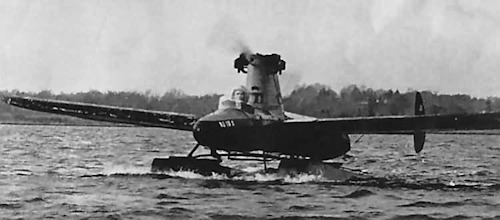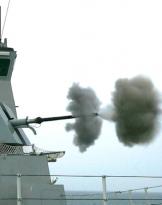In the mid-30s, Russia began building a powerful fleet that included battleships, aircraft carriers and auxiliary ships as well as submarines. On the eve of World War II, a curious design of a flying submarine was proposed, so bizarre that its story and that of its successors are worth telling.
The project, called LPL, was conceived and led by a young naval engineer Boris Ushakov.
Basically, the LPL was a twin-engined double-float seaplane that could transform into a submarine. From 1934 to 1936 the project was repeatedly reworked and, in April 1936, it was examined by a competent commission, which deemed it worthy of consideration and implementation in a prototype. In July 1936, the project was also subjected to scrutiny by the Red Army's military research committee which began verifying the theoretical calculations provided. In 1937 the project was transferred to the “B” department of the Research Committee. However, during the recalculation, inaccuracies were found which led to the project being suspended. But Ushakov, who in the meantime was on duty at the "B" department, in his spare time continued to work out his idea and, in January 1938, a new project was again considered by the second department of the committee.
The final version of the flying submarine would have been an all-metal aircraft capable of flying at an air speed of 100 knots and underwater of about three knots. Six pressurized compartments were provided in its fuselage and wings. The 34 liter Mikulin AM-45 engines were protected in three sealed compartments during the dive. In the fuselage were placed the navigation instruments, a battery and the electric motor for underwater navigation. The remaining compartments were to be used as reservoirs for the ballast water needed for diving.

The fuselage was made with an all-metal duralumin cylinder with a diameter of 1,4m with a wall thickness of 6mm. Before starting the dive phase, the crew moved to the interior compartment as the cockpit would also be flooded. To fill the tanks with water, the same electric motor that ensured the movement under water would be used. The bearing surfaces and the fins would have been built in steel and the floats in duralumin, filled with water with the opening of special valves in order to equalize the pressure on the wings during the dive. Flexible fuel and lubricant tanks would be placed in the fuselage. For corrosion protection, the entire aircraft had to be painted with special paints.
The armament consisted of two 18-inch torpedoes suspended under the fuselage to carry out attacks against ships on the high seas. The operational concept of employment was to identify possible naval targets during aerial reconnaissance, then move away, dive and attack the target while submerged.
In 1938, the Red Army Military Research Committee decided to slow the project on the basis of an operational assessment. In the case of a real mission, the enemy ship, once the plane was identified, would certainly have changed course so that the plane, once immersed, would never have been able to intercept it. In 1939 the project was temporarily suspended and classified. In 1943, by order of the head of the NKVD Lavrentiy Beria, it was revived and, in 1947, the first test of the flying submarine was finally carried out. The results are not known but probably not exciting given that, in 1953, in the middle of the Cold War, the project was definitively closed by order of the first secretary of the Communist Party Nikita Khrushchev.
American projects: from Harringon to the Ocean Flyer
After the Second World War, the USN faced the problem of how to solve three operational requirements: to covertly attack an enemy fleet underwater, to launch their torpedoes and, once discovered, to be able to quickly escape to safety.
 The development of increasingly sophisticated anti-submarine systems (ASW) made practically every attack carried out with a conventional submarine, the most silent underwater weapon of the moment, a suicide mission. After the launch of its weapons, the submarine would have had no escape, due to its slowness, now closed within a network made up of enemy ships and planes that could track it with sonar and attack it with torpedoes and depth bombs. A very visionary solution could be a craft capable of navigating underwater in the stage covert and then, after the attack, emerge and move away at great speed. Who better than a plane?
The development of increasingly sophisticated anti-submarine systems (ASW) made practically every attack carried out with a conventional submarine, the most silent underwater weapon of the moment, a suicide mission. After the launch of its weapons, the submarine would have had no escape, due to its slowness, now closed within a network made up of enemy ships and planes that could track it with sonar and attack it with torpedoes and depth bombs. A very visionary solution could be a craft capable of navigating underwater in the stage covert and then, after the attack, emerge and move away at great speed. Who better than a plane?
In 1945, an American inventor, Houston Harrington, filed a patent application for an oddly defined medium "Combination of an airplane and a submarine". In 1956, U.S. Patent No. 2720367, concerning a flying mini-submarine able to take off and land on the water and then dive, propelled in the underwater phase with an electric motor. In its flight phase it would use two jet engines, which were then pressurized once submerged.
Donald V. Reid in the early 60s built a scale radio controlled model with dimensions of 1 × 1 meter. The craft was patented as a flying submarine in June 1963, accompanied by explanatory drawings. In 1964, his invention was published in one of the most popular scientific journals in America. In the article, the prototype was called Triphibia.
The idea aroused the interest of the military and a feasibility study of the project was assigned to Consolidated Vultee Aircraft Corporation and Electric Boat (a division of General Dynamics). In 1964, Reid, hired by the United States Navy, built a large-scale replica of the flying submarine, named Commander-one, in Asbury Park, New Jersey, becoming America's first flying submarine. This prototype can still be seen at the Mid-Atlantic Museum in Reading, Pennsylvania.
 A second working prototype, called Commander-one (RFS-1), was tested in all its modes and proved to be able to dive to a depth of 2 meters, navigate underwater at a speed of 4 knots, and to be able to fly at a speed of about 100 km / h. The first flight took place on July 9, 1964. After diving to a depth of 2 meters, the Commander-one it returned to the surface and took off by flying a short course at low altitude (an altitude of 10 meters). The pilot breathed from a self-contained breathing apparatus and was in an open cockpit during underwater movement. In the tail was an electric motor with a power of 736 watts. When in flight it used a single 65hp four-cylinder internal combustion engine.
A second working prototype, called Commander-one (RFS-1), was tested in all its modes and proved to be able to dive to a depth of 2 meters, navigate underwater at a speed of 4 knots, and to be able to fly at a speed of about 100 km / h. The first flight took place on July 9, 1964. After diving to a depth of 2 meters, the Commander-one it returned to the surface and took off by flying a short course at low altitude (an altitude of 10 meters). The pilot breathed from a self-contained breathing apparatus and was in an open cockpit during underwater movement. In the tail was an electric motor with a power of 736 watts. When in flight it used a single 65hp four-cylinder internal combustion engine.
This prototype stood out from the previous ones by not having floats, but using its aerodynamic fuselage like the hull of a boat to land on the water. In an article in the September 1964 issue of the Naval Institute Proceedings (p 144), a hydrodynamic engineer, Eugene Handler, of the US Bureau of Naval Weapons claimed that this flying submarine would be ideal for attacking Soviet ships in the Baltic and Black Seas. In fact, Convair drew up detailed designs and even built scale models which were tested with promising results but the project did not go beyond the design phase and was canceled by Congress in 1966.
Based on the results of the construction of Reid's prototype, theaeroships, a jet plane with ramjet engines. Landing on the water was carried out on retractable floats, which outwardly resemble water skis. Just before landing, the engines were pressurized. The range was up to 300 km, with a flight speed of about 130 km / h; its underwater speed reached 8 knots. L'aeroships was presented to the public in August 1968 at the New York Industrial Exhibition: in front of the visitors of the exhibition, the flying submarine made a spectacular landing, dived under water and resurfaced. There was no follow-up to this project either.
In 2008, the US Defense Advanced Research Projects Agency (DARPA) announced the study of a clandestine coastal insertion vehicle with aerial, surface and underwater specific abilities called Ocean Flyer.
The study predicts that the aircraft can accommodate eight passengers, including necessary operational equipment, and an additional 2.000 pounds of cargo, with a range of eight hours over 1.000 nautical miles in cruising flight, 200 nautical miles in transit at surface or altitude. very low flight time and 24 nautical miles underwater. An interesting project but… will there be a sequel?
(article originally published on http://www.ocean4future.org)

Photo: web / Werneuchen












